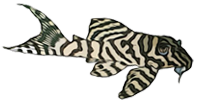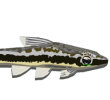Although tempting, I think basing ID on pattern alone is a bit risky. We still tend to use it as a general rule, usually following these conceptions (excluding all other traits like bodyshape, eyesize etc.):
L066 = a lot of thin black lines
L173 = fewer, broader black lines
L236 = even fewer, both broad and narrow black lines and dots
L333 = a lot of thin or sometimes broader black lines
L399/400 = a lot of thin black lines and/or dots
Still most of these varieties are known to contain individuals straying from the norm, confusing the matter even more. This makes me more reluctant to base ID on pattern alone. When we consider the lower Xingu varieties as well and their even more extreme variation, the whole ID'ing issue becomes a severe headache. Tank bred fish is often even harder to tell apart due to the obvious risk of crossbreeding.
My point is that to correctly label the fish which this thread is about is nearly impossible. The originals likely came from somewhere in Rio Xingu, but what they actually were is extremely difficult to answer. Maybe they were two different varieties that looked similar? Maybe not

The line produced by spawning them is certainly nice to look at, but to me they don't fit clearly into any of the l-numbers we know. They don't really match L399 based on how we like to define L399, but I'm open to the possibility anyway.
I think the Xingu holds several slightly different strains of Hypancistrus, naturally separated by the borders within the river that these fish rarely cross. Pick one from this spot, one from that, put them in your boat and bring them to Altamira where they are put in the same holding tank at the exporters (where they also keep the "same" species caught by a different fisherman at a different site) before they are all shipped out to us confused hobbyists under the same name. Then we breed them and wonder why the offspring don't fit the bill.
Haakon













/g/s/1.jpg)